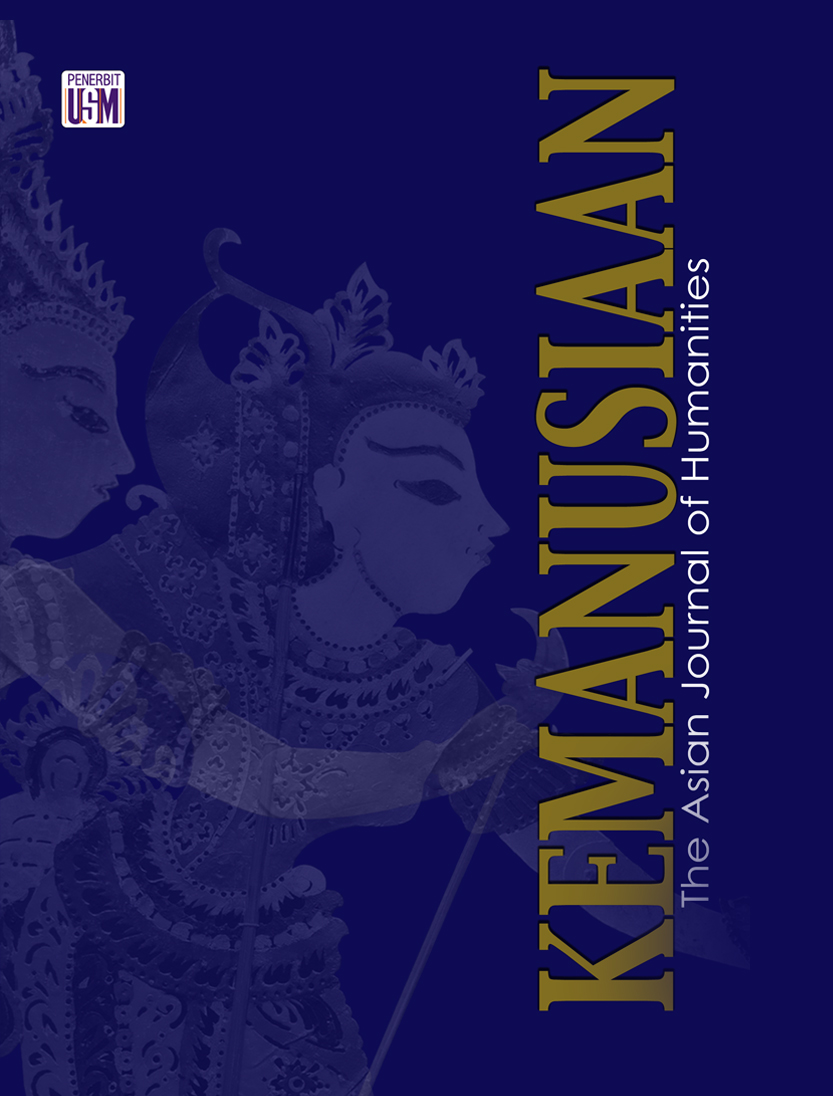KEMANUSIAAN
The Asian Journal of Humanities
Published by
Penerbit Universiti Sains Malaysia
Print ISSN: 1394-9330
Online ISSN: 2180-4257
Frequency: Biannually (April/May and September/October)
Current Issue: Volume 31, No. 1, 2024
Abstracting/Indexing: SCOPUS, Malaysian Citation Index (MyCite) Google Scholar, Directory of Open Access Journals (DOAJ), JURN, Genamics JournalSeek
* The term Kemanusiaan is a Malay word meaning "Humanities". It is derived from the form manu, a Sanskrit term which means "man" or "mankind".
| Submission Guidelines |
KEMANUSIAAN The Asian Journal of Humanities is a peer-reviewed journal. It publishes articles, book reviews, research notes and thesis abstracts covering aspects of the humanities in Asia. Whilst this is the focus, the journal also welcomes contributions covering aspects of the humanities that are universally relevant and provide new knowledge to the broad area of the Humanities. We also encourage submissions that deal with the humanities in non-Asian contexts particularly those that concern the relationships between the two areas.
Submission: Manuscripts should be submitted through the online submission system, ScholarOne Manuscripts™ in MS Word format (.doc or .docx). Authors must first register at http://mc.manuscriptcentral.com/kajh. Please note that from 1st April 2011, only manuscripts submitted via the online submission system will be taken under consideration. All manuscripts must be prepared and submitted according to the journal’s guidelines. Failure to comply will result in the manuscript being unsubmit.
Topic/focus: The focus of the journal is on the Humanities in Asia. Manuscripts that do not discuss research/issues/works in the Humanities within the Asian context or relate to the Humanities in the Asian context will not be considered.
Number of authors: The number of authors for manuscripts that are submitted to this journal should not exceed three. Please note that manuscripts with more than three authors will be rejected upon submission.
The journal only allows one submission per author at any one time. If another manuscript is submitted when there is already one in the system, the second manuscript will be rejected.
Manuscript Preparation
Manuscript structure: Manuscript should consists of introduction, literature review, research methodology, results and discussion, conclusion, acknowledgment (if any) and a complete list of references.
Language: The journal accepts manuscripts written in Malay or in English (UK English).
Title page: The title page should be sent as a separate document from the main text in ScholarOne Manuscripts™. Please give full name (first, middle and last name) but omit titles. Give the affiliation of each author and complete mailing address of the institution where the work was conducted. Please denote the corresponding author with an asterisk (*) and provide the email address of the corresponding author.
Abstract: All manuscripts must be accompanied with a 200-word abstract. Manuscripts written in Malay must include a Malay abstract, as well as abstract and title in English. The abstract needs to contain enough information about the paper, highlighting your findings, methods and discussions.
Keywords: Keywords should represents the content of your manuscript and specific to the field of study. Keywords should not be more than five.
Font and spacing: Please use Times New Roman 12pt and all submissions (original articles, book reviews, research notes and thesis abstracts) should be typed in double spacing (including notes and references).
Length: Manuscripts should be 20–30 pages long (double-spaced, A4-size). Introduction and conclusion sections are compulsory.
Quotations: Quoted words, phrases and sentences should be enclosed in double quotation marks. Quotations within quotations and glosses should be enclosed in single quotation marks. Quotations may be either run in or in the case of quotations which are four lines or longer (or more than 40 words) – set off from the text as block quotations.
Italic: Italicize non-English terms or phrases in manuscripts written in English and italicize non-Malay terms or phrases in manuscripts written in Malay.
Headings:
First-level heading: Title Case & bold
Second-level heading: Sentence case & bold
Third-level heading: Sentence case & italic
Fourth-level heading: Sentence case
Table and illustration:
All tables and figures should be placed as close to the corresponding text as possible. Caption should be set in sentence case and labelled with Arabic numerals (e.g.: Table 1, Figure 1). Figure (image) size is 300 dpi or higher. Table caption is placed at the top section of the table while figure caption is place at the bottom section of the figure. Tables and figures should be submitted as separate files, not embedded in text.
If data for table and figure are taken from other source, please include the source. Author is responsible for acquiring copyright from the appropriate party (such as publisher, person, institution, etc.).
Notes: Notes should be kept to a minimum. Use endnotes, not footnotes. All notes should be numbered in sequence and in Arabic numeral, typed in double spacing and placed at the end of the main text. Notes should contain additional information to the particular discussion. Bibliographic notes are not allowed.
References and text citations: Referencing should follow the author-date system. Author-date citations in the text must agree exactly, in both name and date, with the corresponding entries in the reference list and there must be an entry for every text citation. It is the author's responsibility to ensure such agreement as well as the accuracy of the reference. Please refer to examples below:
Book
Text citation
(Joseph 2004)
(Joseph 2004, 121)
(Hollingsworth and Sockett 1994b; Sandy 2001, 7)
According to Joseph (2004, 36)…
Article in a journal
Contribution in a multi-author book
Dissertation
Online document
Funding source: All sources of funding must be declared in the Acknowledgement section which include source fund and grant number.
Authors can access their articles by downloading directly from the journal’s website.
If you have any enquiries, please contact the Editor-in-Chief at kajh@usm.my.


